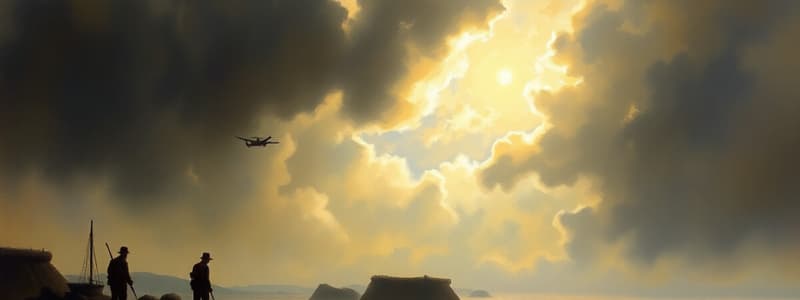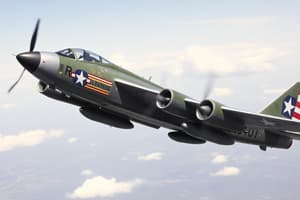Podcast
Questions and Answers
What approach did Major General Curtis LeMay take when he first arrived in the Marianas?
What approach did Major General Curtis LeMay take when he first arrived in the Marianas?
- He expressed dissatisfaction with the Navy's construction efforts. (correct)
- He focused on maintaining continuity with Hansell's methods.
- He immediately developed a fixed bombing strategy.
- He sought to improve the military infrastructure. (correct)
Which significant obstacle did LeMay encounter while trying to execute his bombing missions?
Which significant obstacle did LeMay encounter while trying to execute his bombing missions?
- Ineffectiveness of the bombing strategy.
- Lack of aircraft availability.
- Inability to hit targets due to environmental factors. (correct)
- Limited support from Admiral Nimitz.
How did Admiral Nimitz respond to LeMay's dinner invitation?
How did Admiral Nimitz respond to LeMay's dinner invitation?
- He understood LeMay's point about the military facilities. (correct)
- He offered to send additional food supplies.
- He was impressed by the Quonset hut setting.
- He declined the invitation.
What specific target did LeMay initially focus on for bombing missions?
What specific target did LeMay initially focus on for bombing missions?
What did LeMay conclude about Hansell's previous missions?
What did LeMay conclude about Hansell's previous missions?
What was one of LeMay's main concerns that led to changes in the bombing strategy?
What was one of LeMay's main concerns that led to changes in the bombing strategy?
What altitude did LeMay decide to have his bombers fly during bombing runs?
What altitude did LeMay decide to have his bombers fly during bombing runs?
How did LeMay plan to overcome the challenges of visual bombing?
How did LeMay plan to overcome the challenges of visual bombing?
What was the general reaction of the audience when LeMay announced changes to the bombing strategy?
What was the general reaction of the audience when LeMay announced changes to the bombing strategy?
What was a significant factor that influenced LeMay's decision to change to night raids?
What was a significant factor that influenced LeMay's decision to change to night raids?
What was a significant concern for Haywood Hansell regarding General LeMay's approach to low-level flight?
What was a significant concern for Haywood Hansell regarding General LeMay's approach to low-level flight?
What was the impact of General LeMay's low-level bombing strategy on the cities of Japan?
What was the impact of General LeMay's low-level bombing strategy on the cities of Japan?
How did General LeMay justify his aggressive bombing strategy?
How did General LeMay justify his aggressive bombing strategy?
What led to Haywood Hansell's exit from command?
What led to Haywood Hansell's exit from command?
What percentage of Toyama was destroyed due to the bombing campaign led by LeMay?
What percentage of Toyama was destroyed due to the bombing campaign led by LeMay?
Flashcards
LeMay's dissatisfaction with Marianas infrastructure
LeMay's dissatisfaction with Marianas infrastructure
Major General LeMay, upon taking command, found the military facilities in the Marianas inadequate, criticizing their primitive nature, believing the facilities were unsuitable for operations.
LeMay's differing approach to Hansell
LeMay's differing approach to Hansell
Unlike his predecessor, Haywood Hansell, who was inflexible and principled, LeMay was adaptable and open-minded, willing to alter strategies as necessary.
LeMay's initial bombing strategy failure
LeMay's initial bombing strategy failure
LeMay's first bombing missions against the Nakajima aircraft plant in Tokyo, despite deploying numerous B-29s, failed to destroy the plant, mirroring the failures of his predecessor.
Impact of the jet stream on bombing missions
Impact of the jet stream on bombing missions
Signup and view all the flashcards
Impact of Nimitz's visit on LeMay's strategy
Impact of Nimitz's visit on LeMay's strategy
Signup and view all the flashcards
LeMay's bombing strategy
LeMay's bombing strategy
Signup and view all the flashcards
Precision bombing doctrine
Precision bombing doctrine
Signup and view all the flashcards
Night bombing
Night bombing
Signup and view all the flashcards
Weather dependence
Weather dependence
Signup and view all the flashcards
Low-altitude bombing
Low-altitude bombing
Signup and view all the flashcards
LeMay's low-altitude bombing plan
LeMay's low-altitude bombing plan
Signup and view all the flashcards
LeMay's decision-making
LeMay's decision-making
Signup and view all the flashcards
Tokyo firebombing impact
Tokyo firebombing impact
Signup and view all the flashcards
Japanese Cities Targeted
Japanese Cities Targeted
Signup and view all the flashcards
Casualties from bombing raids
Casualties from bombing raids
Signup and view all the flashcards
Study Notes
Military Historian Conrad Crane on Major General Curtis LeMay
- LeMay took command of the Twenty-First Bomber Command in January 1945.
- LeMay initially disagreed with the Navy's facilities in the Marianas.
- He observed a lavish dinner with Admiral Nimitz, highlighting a stark contrast in conditions.
- LeMay implemented a revised bombing strategy, targeting the Nakajima aircraft plant in Tokyo.
- LeMay disagreed with and revised Hansell's strategy, due to military facilities, weather, and other obstacles.
LeMay's Strategy Revisions
- LeMay prioritized addressing weather conditions, particularly jet streams and heavy cloud cover, influencing tactics.
- He moved to lower altitudes and night raids to avoid Japanese air defenses.
- Precision bombing was abandoned in favor of wider attacks (to increase impact) to achieve results.
- He employed incendiary weapons (napalm).
- LeMay's revision focused on exploiting weaknesses including the infrastructure and personnel, and weather conditions.
LeMay's Attack on Tokyo
- LeMay's first major attack on Tokyo occurred in March 1945.
- LeMay's attack involved hundreds of B-29 bombers.
- The attack used napalm bombs causing a widespread firestorm.
- LeMay's prioritized and revised strategy was remarkably successful, despite initial resistance.
- The attack led to significant destruction.
LeMay's Legacy and Tactics
- LeMay's approach was criticized by some, highlighting potential moral dilemmas.
- LeMay's approach was viewed by others as an essential tactic.
- LeMay believed in maximizing efficiency through speed and volume.
- LeMay stressed speed over targeting and focused on the sheer volume of attacks.
- LeMay and others in his generation viewed war as fundamentally a matter of efficiency and speed. Historians and military experts differ on whether LeMay engaged in unethical and overly destructive practices.
Studying That Suits You
Use AI to generate personalized quizzes and flashcards to suit your learning preferences.




